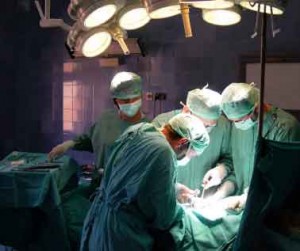New Study Suggests Morcellation Should Not Be Banned
 The electric morcellation of uterine fibroids may result in intraperitoneal dissemination of occult leiomyosarcomas, which can worsen an already poor prognosis, according to recent analysis Prevalence of Unexpected Leiomyosarcoma at Myomectomy: A Descriptive Study. However, the researchers note that the use of morcellation may not be harmful in all cases.
The electric morcellation of uterine fibroids may result in intraperitoneal dissemination of occult leiomyosarcomas, which can worsen an already poor prognosis, according to recent analysis Prevalence of Unexpected Leiomyosarcoma at Myomectomy: A Descriptive Study. However, the researchers note that the use of morcellation may not be harmful in all cases.
Laparoscopic power morcellators are devices used in different types of minimally invasive surgeries, such as procedures to remove uterine fibroids. The U.S. Food and Drug Administration has warned that morcellators pose a risk of spreading unsuspected cancerous tissue — notably sarcomas beyond the uterus — when used for hysterectomy or myomectomy.
The FDA notes this may happen in one out of every 498 procedures, so myoma morcellation is being extremely limited. It is important to note that age is a risk factor and the peak incidence of leiomyosarcomas is in patients over 50 years of age. Consequently, patients from different age groups undergoing myomectomy or hysterectomy should be considered separately. The main objective of the research team was to find the prevalence of unexpected leiomyosarcomas in a large sequence of myomectomies.
Morcellation study
The researchers searched the databases of their center to find the number of myomectomies performed at laparoscopy or laparotomy during the 15 year period from January 1999 to December 2013. The team reviewed pathology reports and crosschecked them with those of their gynecologic oncology service. Their goal was to determine the frequency of leiomyosarcomas and tumors with atypical features that were not discovered preoperatively.
Myomectomies were performed in 2,356 women with a mean ± SD age of 39 ± 6 years at laparoscopy in 1,388 cases and at laparotomy in 968 cases, noted the researchers. During the period of 2008 to 2013, only one-third of patients underwent myomectomy at laparotomy and all fibroids removed endoscopically were morcellated.
The team found one case of leiomyosarcoma in a 39-year-old woman with an 8-cm tumor and one case of smooth muscle tumor of uncertain malignant potential (STUMP) in a 47-year-old woman with a 9-cm lesion. Both patients underwent a laparoscopic procedure. The proportion of leiomyosarcoma was 0.04%. Taking the STUMP case into consideration as well, the percentage of unexpected tumors was 0.08%. The woman with the sarcoma passed away four months after her myomectomy, but the patient with the STUMP was cancer-free at her two-year checkup.
Risk of leiomyosarcoma low in younger women
The researchers concluded that the risk of unexpected leiomyosarcoma was less than 1/2,000. The proportion of unexpected tumors was less than 1/1,000 — including the STUMP case — which was much lower than the amount indicated by the FDA. However, it is important to note that the FDA estimate was mainly centered on hysterectomy series, where the risk of occult leiomyosarcoma should be greater, as women are typically older than those undergoing myomectomy.
Myomectomy is not an “intact” procedure — even at laparotomy — as the myometrium is cut open and the leiomyoma is removed through aggressive retraction, which involves putting sharp clamps into it, noted the researchers. Mechanistically, this should also have a risk of tissue dissemination. Therefore, myoma morcellation in a bag could limit intraperitoneal dissemination of malignant cells, but the effectiveness of containment devices has not yet been proven. These devices could also be used during transvaginal extraction for myoma retrieval after laparoscopic myomectomy.
The occurrence of unexpected leiomyosarcoma during myomectomy is very low in young women, according to the research team.
They concluded that if power morcellation was banned, the major downfall would be having to impose a substantial additional morbidity in women undergoing an open procedure, as opposed to a minimally invasive one.
- American Journal of Obstetrics and Gynecology, Prevalence of Unexpected Leiomyosarcoma at Myomectomy: A Descriptive Study http://www.ajog.org/article/S0002-9378(15)01206-5/pdf
- U.S. Food and Drug Administration, UPDATED Laparoscopic Uterine Power Morcellation in Hysterectomy and Myomectomy: FDA Safety Communication http://www.fda.gov/MedicalDevices/Safety/AlertsandNotices/ucm424443.htm


 Resources
Resources
 Resources
Resources
